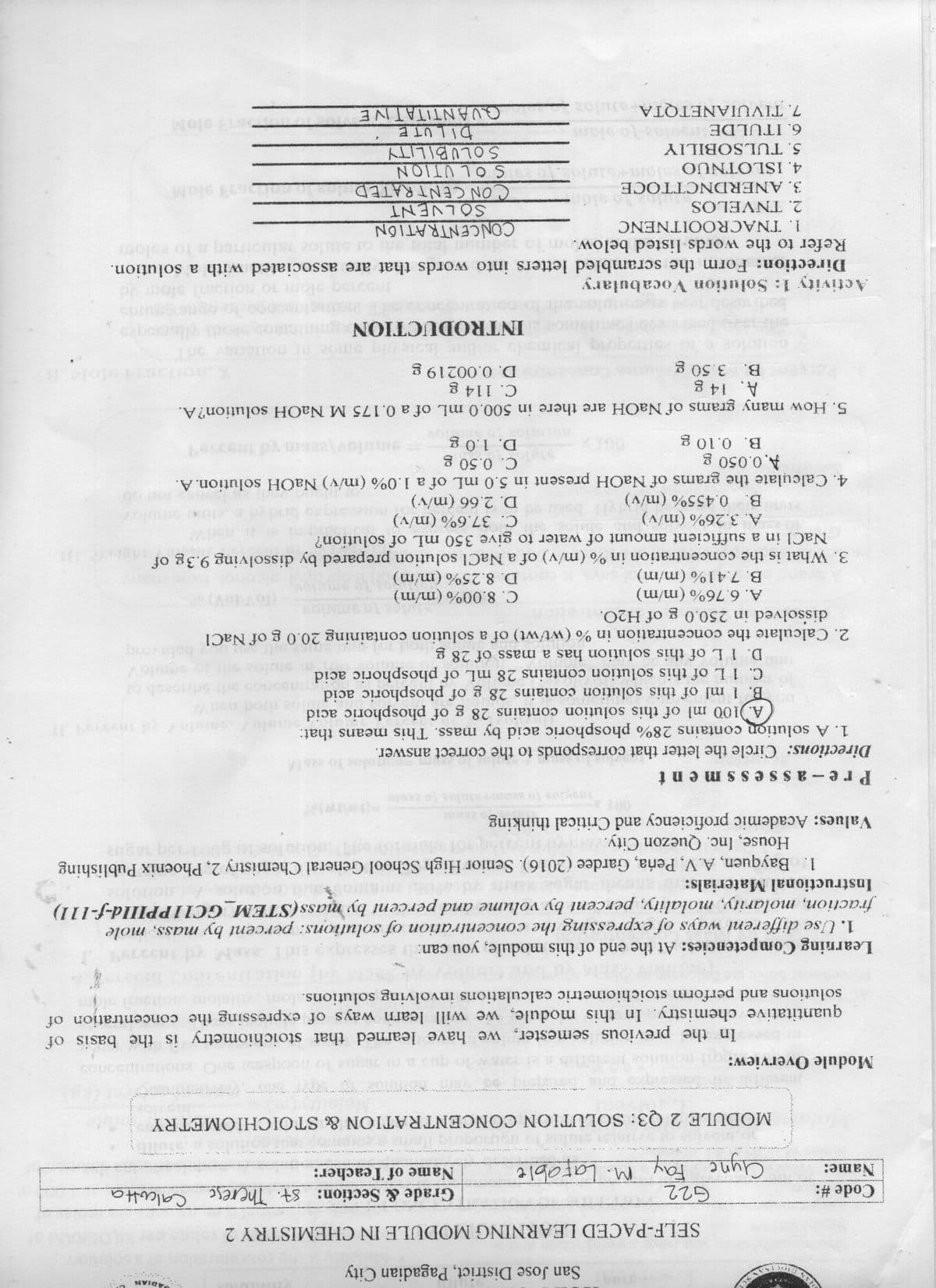1. A solution contains 28% phosphoric acid by mass. This means that: A.)100 ml of this solution contains 28 g of phosphoric acid B. I ml of this solution contains 28 g of phosphoric acid C. 1 L of this solution contains 28 mL of phosphoric acid
1. A solution contains 28% phosphoric acid by mass. This means that: A.)100 ml of this solution contains 28 g of phosphoric acid B. I ml of this solution contains 28 g of phosphoric acid C. 1 L of this solution contains 28 mL of phosphoric acid
Chapter3: Statistical Tests With Excel
Section: Chapter Questions
Problem 5P
Related questions
Question
100%
1-5 multiple choice ONLY

Transcribed Image Text:4DIAN
San ose istrict, agadian City
SELF-PACED LEARNING MODULE IN CHEMISTRY 2
Code #:
Grade & Section: 84. Therese Calcutta
Name of Teacher:
Clyne Fay M. Lafable
Name:
MODULE 2 Q3: SOLUTION CONCENTRATION & STOICHIOMETRY
Module Overview:
COUC
In the previous semester, we have learned that stoichiometry is the basis of
quantitative chemistry. In this module, we will learn ways of expressing the concentration of
solutions and perform stoichiometric calculations involving solutions. omilelo
Learning Competencies: At the end of this module, you can:
1. Use different ways of expressing the concentration of solutions: percent by mass, mole
fraction, molarity, molality, percent by volume and percent by mass(STEM GC11PPIIId-f-111)
Instructional Materials:
1. Bayquen, A, V, Pena, Gardee (2016). Senior High School General Chemistry 2, Phoenix Publishing
House, Inc. Quezon City. d
Values: Academic proficiency and Critical thinking
anoL be
Directions: the letter that corresponds to the correct answer.
olor lo sanM
Pre-assessment
1. A solution contains 28% phosphoric acid by mass. This means that:
A.)100 ml of this solution contains 28 g of phosphoric acid
B. 1 ml of this solution contains 28 g of phosphoric acid
C. 1 L of this solution contains 28 mL of phosphoric acid
D. 1Lof this solution has a mass of 28 g
diod ns
2. Calculate the concentration in % (wt/wt) of a solution containing 20.0 g of NaCl
dissolved in 250.0 g of H2O.
C. 8.00% (m/m)
D. 8.25% (m/m)
3. What is the concentration in % (m/v) of a NaCl solution prepared by dissolving 9.3g of
biozigeg
A. 6.76% (m/m)
B. 7.41% (m/m)
NaCl in a sufficient amount of water to give 350 mL of solution?
C. 37.6% (m/v)
D. 2.66 (m/v)
A. 3,26% (m/v)
B.
0.455% (m/v)
4. Calculate the grams of NaOH present in 5.0 mL of a 1.0% (m/v) NaOH solution. A.
C. 0.50 g
D. 1.0 g
A.0.050 g
B. 0.10 g
5. How many grams of NaOH are there in 500.0 mL of a 0.175 M NAOH solution?A.
C. 114 g
D. 0.00219 g
A. 14 g
B. 3.50 g
LUG A9 IoU I 201c DAICS
bo
INTRODUCTION
caborr
wil olom vd
Activity 1: Solution Vocabulary
Direction: Form the scrambled letters into words that are associated with a solution.
CONCENTRATION
SOLVENT
CONCENTRATED
Refer to the words listed below. m
Tsluoineg s to eslom
1. TNACROOITNENC
2. TNVELOS
3. ANERDNCTTOCE
4. ISLOTNUo omsi02.1029SOLUTION
5. TULSOBILIY
6. ITULDE i0lo elom
7. TIVUIANETQTA o:-
SOLUBILITY
QUANTITATIVE
Expert Solution
This question has been solved!
Explore an expertly crafted, step-by-step solution for a thorough understanding of key concepts.
This is a popular solution!
Trending now
This is a popular solution!
Step by step
Solved in 2 steps

Knowledge Booster
Learn more about
Need a deep-dive on the concept behind this application? Look no further. Learn more about this topic, chemistry and related others by exploring similar questions and additional content below.Recommended textbooks for you



Principles of Instrumental Analysis
Chemistry
ISBN:
9781305577213
Author:
Douglas A. Skoog, F. James Holler, Stanley R. Crouch
Publisher:
Cengage Learning



Principles of Instrumental Analysis
Chemistry
ISBN:
9781305577213
Author:
Douglas A. Skoog, F. James Holler, Stanley R. Crouch
Publisher:
Cengage Learning